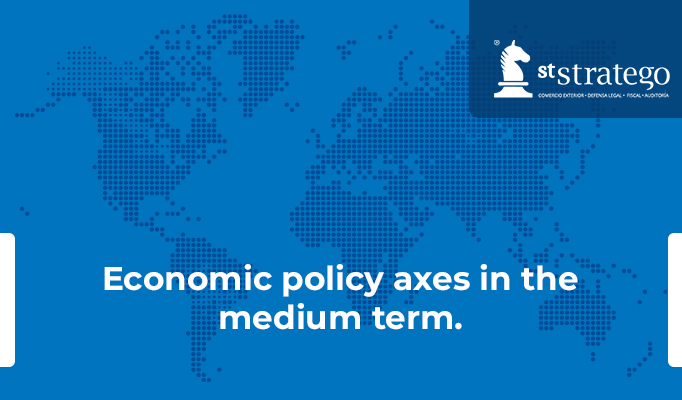As part of the 2024 economic package presented a few days ago, the government shares the economic policy axes that it will follow for the same year, therefore it is relevant to know them a little more in detail, since they dictate the way in which an accelerated economic development is sought.
Long-term risks and contingent liabilities
To maintain long-term economic and fiscal stability, fiscal policy considers risks that could affect public finances. These risks include the aging of the population and its implications for pensions and the demand for health services. Financial obligations related to the pension system and potential natural disasters are also taken into account.
a) With regard to the aging population , it is expected that by 2050, people over 65 years of age will represent approximately 17% of the total population. This poses challenges for the sustainability of pension systems and health care. Changes have been made to pension systems to ensure their sustainability, including the transformation to individual account systems managed by AFOREs. An increase in the net assets of AFOREs has been observed.
In addition, the Pension for the Welfare of the Elderly has been increased, benefiting a growing number of elderly people. This expenditure represents a significant portion of GDP.
b) In the development banking sector, risks are centered on non-compliance with loans and guarantees granted. As of June 2023, the balance of the loan portfolio amounted to a considerable amount, but is considered low risk due to rigorous standards in the granting of loans and adequate collateral.
c) In the event of contingencies leading to the liquidation of banking institutions, the Federal Government undertakes to cover deposits up to a certain guaranteed amount. As of June 2023, the total amount of deposits in the system represents a proportion of GDP. The Mexican financial system is sound, with a high capitalization ratio and a low non-performing loan portfolio.
d) Long-term infrastructure projects (Pidiregas) were discontinued for PEMEX in 2009, and CFE is the only entity that currently uses them. The corresponding debt was converted into public debt, and the risks are mitigated by strict contractual conditions.
e) A natural disaster loss assessment system has been in place since 2007. Expected losses are estimated for different types of natural events, which helps to prepare for them. Expected losses are calculated for high-frequency and low-intensity events, events with 5% annual probability, and events with 1% annual probability. These risks are monitored and managed to ensure the country’s economic and fiscal stability.
Medium-term development triggers
Economic development of the southern region of the country
In the context of the current administration, one of the key objectives has been to promote economic development in the southern region of Mexico, which includes states such as Campeche, Chiapas, Oaxaca, Quintana Roo, Tabasco, Veracruz and Yucatán. To achieve this, comprehensive regional development policies have been implemented.
These policies seek to take advantage of the productive potential of these states to stimulate investment, employment and economic growth. The focus is on reducing poverty and regional inequalities, while improving the region’s connectivity and integration into global value chains.
A fundamental pillar of this strategy is investment in infrastructure. Projects such as the Olmeca-Dos Bocas refinery, which will increase hydrocarbon production and contribute to energy self-sufficiency, stand out. The Mayan Train will connect tourist centers and improve the transportation of goods. The Interoceanic Corridor of the Isthmus of Tehuantepec will boost connectivity between the Pacific and Atlantic oceans, with improvements in ports and railroads.
In order to attract investment to the development hubs in Veracruz and Oaxaca, tax benefits have been granted to companies operating in these areas. These incentives include tax credits, deductions and VAT exemptions.
The results of these policies are already evident in the region. Economic activity in the south has outpaced that of the rest of the country, and job creation has been notable, especially in sectors related to investment projects. Formal employment has also grown significantly.
In addition, the coverage of social programs in the region has been expanded, which has contributed to reducing poverty. The rate of population living in poverty has decreased, and this trend is expected to continue in the coming years, allowing for greater economic and social convergence between the southern region and the rest of the country. It is estimated that if the per capita income gap is reduced by 50% in the next decade, this could contribute significantly to the region’s economic growth.
Reconfiguration of global value chains
Mexico has become a key investment destination due to the reconfiguration of global value chains. This is due to the trend of companies relocating closer to their target markets, as well as the boost to manufacturing in the United States.
Initially, this reconfiguration benefited Mexico’s northern border states and some Bajio regions, due to their proximity to the United States and their strong industrial base. This resulted in a high demand for industrial space, with cities such as Tijuana and Ciudad Juarez showing less than 1% availability and an increase in rental prices.
This increase in demand led to a significant increase in the construction of new industrial areas and factories, which in turn boosted employment in the construction sector in the northern and north-central regions of Mexico.
The municipalities near the border with the United States experienced greater activity due to their geographic importance and industrial base. In addition, special programs and incentives were implemented in this region. Employment in the construction sector in the Northern Border Free Zone grew steadily at rates above 10%.
Growth in the construction sector was also reflected in construction-related imports, such as cement, bricks, pipes and screws.
Foreign direct investment (FDI) also benefited from this trend, with an increase of 41% in the first half of 2023 compared to the previous year. Manufacturing was the leading sector for FDI, especially in transportation equipment, basic metal industries, and beverages and tobacco.
In the United States, laws were implemented to boost the manufacturing industry, resulting in significant growth in the construction of manufacturing plants. This, in turn, increased demand for Mexican imports and strengthened the trade relationship between Mexico and the United States.
In summary, the reconfiguration of global value chains and investment in manufacturing are driving economic growth in Mexico and strengthening its position as a key trading partner of the United States. Mexico has gained share in U.S. imports, while China has lost ground in this regard.
At Stratego, we have an expert team in economic research that generates valuable data for our clients, facilitating investment decisions. If you are interested in additional details, please do not hesitate to contact us.
This document does not constitute a particular consultation, and therefore, Asesores Stratego SC, is not responsible for the interpretation or application given to it. The total or partial reproduction of this publication, by any means or procedure, is prohibited without the prior, express and written authorization of the author. Any form of unauthorized use will be prosecuted in accordance with the provisions of the Federal Copyright Law. We are at your service to answer your questions or comments, for more information on this subject and our services, please contact us at: info@stratego-st.com
or application given to it. The total or partial reproduction of this publication, by any means or procedure, is prohibited without the prior, express and written authorization of the author. Any form of unauthorized use will be prosecuted in accordance with the provisions of the Federal Copyright Law. We are at your service to answer your questions or comments, for more information on this subject and our services, please contact us at: info@stratego-st.com




